Difference between revisions of "Testing Article1"
| Line 1: | Line 1: | ||
| − | == | + | ==Overview Flow Chart== |
| − | + | <center>[[File:P70-7_1_1-70-(1)-08052019.png]]</center> | |
| + | <!--<center>P70-7_1_1-70-(1)-08052019.png</center>--> | ||
| − | == | + | ==Procedure== |
| − | + | ===Preparing the Microsoft Project Source Plan=== | |
| − | + | Launch Microsoft Project and access the required Microsoft Project '''source plan'''. Set the '''Flags/Numbers''' field into the Microsoft Project '''source plan'''. This is the '''flag''' that OnePager uses to determine which tasks and milestones to '''import'''. Determine which of the tasks and milestones are to be included and set the '''Flags/Numbers''' field cell to '''Yes''' for these while leaving the remainder of the task's and milestone's '''Flag''' field set to '''No''', '''0''', or blank. | |
| − | + | ||
| − | + | ===Launching OnePager Pro Add-In=== | |
| − | + | Click the '''OnePager''' button on the Microsoft Project '''ADD-INS''' ribbon tool bar tab to launch OnePager Pro at the '''OnePager Pro Start''' form. | |
| − | + | ||
| − | + | <center>[[File:P70-7_1_1-70-(2)-08052019.png]]</center> | |
| + | <!--<center>P70-7_1_1-70-(2)-08052019.png</center>--> | ||
| − | + | If you need to adjust settings in the OnePager current '''Template Properties''' form before launching OnePager Pro, click the '''Template...''' button on the Micosoft Project '''ADD-INS''' ribbon tool bar tab accesses a window with the '''Template Properties''' form which can be '''edited''' and '''saved'''. | |
| − | + | <center>[[File:P70-7_1_1-70-(3)-05042020.png]]</center> | |
| + | <!--<center>P70-7_1_1-70-(3)-05042020.png</center>--> | ||
| − | + | The '''Template Properties''' form is very similar to the OnePager '''Chart Properties''' form which is described elsewhere. Once the desired '''edits''' to the current '''Template Properties''' form are made, '''save''' the '''Template Properties''' form and return to paragraph 5) above. At the completion of paragraph 5) when you click the '''NEW''' button, OnePager accesses the '''OnePager choices''' ('''OPC''') form as shown below: | |
| − | : | + | <center>[[File:P70-7_1_1-70-(4)-08052019.png]]</center> |
| − | + | <!--<center>P70-7_1_1-70-(4)-08052019.png</center>--> | |
| − | + | ||
| − | + | ||
| − | + | ||
| − | + | It is recommended that the '''chart name''' selected refer to both the project and, perhaps, be familiar to the audience that is likely to view the completed OnePager chart. Additionally, notice that the '''Select Tasks with ‘YES’ in field:''' is showing '''Flag20''' as a default. Most users select '''Flag20''' to tell OnePager which tasks and milestones to '''import''' but any of the 20 '''Flag''' fields or any of the 20 '''Number''' fields can be used. It is important that the '''Flag''' field number represented in this window correspond to the '''Flag''' field containing the '''Yes''' and '''No''' data placed in the Microsoft Project '''source plan'''. | |
| − | + | The '''Snapshot date''' represents the '''time now''' or '''as-of date''' for the chart you are about to create. If the '''date created''' by OnePager does not reflect the '''status date''' required, change the '''date''' by using the '''calendar''' dropdown window. As the '''source plan''' changes later on, you can create additional snapshots to show changes consistently. | |
| − | + | Finally, note that the '''Show field mappings''' checkbox is checked '''ON''' as shown above. Checking this checkbox '''ON''' and pressing the '''Next>''' button takes you to the second page of the '''OPC''' form shown below: | |
| − | + | <center>[[File:P70-7_1_1-70-(5)-08052019.png]]</center> | |
| + | <!--<center>P70-7_1_1-70-(5)-08052019.png</center>--> | ||
| − | + | This form allows you to '''edit''' which Microsoft Project '''source plan''' fields are used for various purposes such as the '''Start''' field and the '''Color by''' field. The '''Edit current template''' button also gives you a second opportunity to '''edit''' many more initial properties of the chart by accessing the current '''Template Properties''' form. Once these choices are confirmed or '''edited''', click the '''Create new chart''' button and OnePager '''imports''' the '''flagged data''' and creates the chart. | |
| − | + | Once the chart is created, you can '''edit''' by right-clicking task bars and milestone symbols and using the context menus commands. You can also left-click on task bars and milestone symbols and use the '''editing Icons''' on the OnePager ribbon tool bar tabs. You can also left-click on a task bar or milestone symbol and use the mouse to drag the selected task bar or milestone symbol up or down from '''row to row''' in the chart. When the desired '''editing''' is complete, click the '''Copy to Clipboard''' button on the OnePager '''Home''' ribbon tool bar tab and then '''paste''' the chart into a Microsoft PowerPoint presentation, email message, or Microsoft Word document. If the chart contains more than one page, you can choose to copy the entire document, the last page (current page), or a selected numerical page to the clipboard. OnePager can '''save''' all charts and snapshots after '''editing'''. | |
| − | + | ==Related Links== | |
| − | + | [[Creating a NEW Chart via Pull Operation - OnePager Pro for Version 7.0 | Creating a NEW Chart via Pull Operation - OnePager Pro]] <!--7.13.1-70 --> | |
| − | + | [[Creating a NEW Chart via Pull Operation - OnePager Express for Version 7.0 | Creating a NEW Chart via Pull Operation - OnePager Express]] <!--7.13.2-70 --> | |
| − | + | [[REPLACING a Snapshot via Pull Operation - OnePager Pro for Version 7.0 | REPLACING a Snapshot via Pull Operation - OnePager Pro]] <!--7.14.1-70 --> | |
| − | <!-- | + | |
| − | + | [[REPLACING a Snapshot via Pull Operation - OnePager Express for Version 7.0 | REPLACING a Snapshot via Pull Operation - OnePager Express]] <!--7.14.2-70 --> | |
| − | + | [[ADDING a Snapshot via Pull Operation - OnePager Pro for Version 7.0 | ADDING a Snapshot via Pull Operation - OnePager Pro]] <!--7.15.1-70 --> | |
| − | + | [[ADDING a Snapshot via Pull Operation - OnePager Express for Version 7.0 | ADDING a Snapshot via Pull Operation - OnePager Express]] <!--7.15.2-70 --> | |
| − | + | [[Custom Update (Replacing) of a Snapshot via Pull Operation - OnePager Pro for Version 7.0 | Custom Update (Replacing) of a Snapshot via Pull Operation - OnePager Pro]] <!--7.16.1-70 --> | |
| − | <!-- | + | |
| − | + | [[Custom Update (Replacing) of a Snapshot via Pull Operation - OnePager Express for Version 7.0 | Custom Update (Replacing) of a Snapshot via Pull Operation - OnePager Express]] <!--7.16.2-70 --> | |
| − | + | [[Using the OnePager "Data" Tab's "Selected file(s)" Button for Version 7.0 | Using the OnePager "Data" Tab's "Selected file(s)" Button]] <!--7.17.1-70 --> | |
| − | + | (7.1.1-70) | |
| − | + | [[Category:Version 7.0]] | |
| + | [[Category:Add-in]] | ||
| + | [[Category:Basic Workflows]] | ||
| + | [[Category:Chart Properties Form]] | ||
| + | [[Category:OnePager Choices Form]] | ||
| + | [[Category:Snapshots]] | ||
| + | [[Category:Charts]] | ||
| + | [[Category:OnePager Pro]] | ||
| − | + | ==Overview Flow Chart== | |
| − | + | <center>[[File:P70-7_1_2-70-(1)-08052019.png]]</center> | |
| + | <!--<center>P70-7_1_2-70-(1)-08052019.png</center> --> | ||
| − | == | + | ==Procedure== |
| − | + | ===Preparing The Microsoft Project Source Plan=== | |
| − | + | After launching Microsoft Project with your desired '''source plan''', set '''Flags/Numbers''' field into the Microsoft Project '''source plan'''. This is the '''Flag''' that OnePager uses to determine which tasks and milestones to '''import'''. Determine which of the tasks and milestones are to be included and set the '''Flags/Numbers''' field cell to '''Yes''' for these while leaving the remainder of the task's and milestone's '''Flag''' field set to '''No''', '''0''', or blank. At this point your Microsoft Project '''source plan''' can be '''saved''' and '''closed'''. The '''Desk top''' version of OnePager Pro does not require that the Microsoft Project '''source plan''' be launched first. The part of the procedure described above are in preparation for using the '''Desk top''' version of OnePager Pro. | |
| − | + | ||
| − | === | + | ===Launching OnePager Pro Desktop=== |
| − | + | Launch OnePager from the '''Desktop Icon'''. The OnePager '''splash page''' appears briefly followed by the OnePager '''Chart Editor''' form displaying the '''OnePager Pro Start''' form as shown below: | |
| − | + | <center>[[File:P70-7_1_2-70-(2)-08052019.png]]</center> | |
| + | <!--<center>P70-7_1_2-70-(2)-08052019.png</center> --> | ||
| − | + | At the completion of paragraph 6) when you click the “NEW” button, OnePager displays an abbreviated '''OnePager choices''' ('''OPC''') form. | |
| − | + | <center>[[File:P70-7_1_2-70-(3)-08052019.png]]</center> | |
| + | <!--<center>P70-7_1_2-70-(3)-08052019.png</center> --> | ||
| − | + | When you click the '''Select''' button shown above, OnePager then provides a dropdown menu for you to either choose to use the '''BROWSE FILES...''' to select a '''source plan''' or click the '''RECENT MS Project Files...''' option to access Microsoft Project Server '''source files''' as shown above. Clicking the '''BROWSE FILES…''' option as shown above accesses a Windows '''Open''' form where you can select a Microsoft Project '''source plan''' to load as shown here: | |
| − | + | ||
| − | + | <center>[[File:P70-7_1_2-70-(4)-08052019.png]]</center> | |
| + | <!--<center>P70-7_1_2-70-(4)-08052019.png</center> --> | ||
| − | + | When you click the '''Open''' button on the Windows '''Open''' form above, OnePager loads the selected Microsoft Project '''source plan''' and provide you with the expanded '''OPC''' form so that you can confirm or '''edit''' the settings before OnePager creates the new chart. | |
| − | + | <center>[[File:P70-7_1_1-70-(4)-08052019.png]]</center> | |
| + | <!--<center>P70-7_1_1-70-(4)-08052019.png</center> --> | ||
| − | + | As shown above, OnePager displays the loaded Microsoft Project '''source plan''' in the '''Selected File(s)''' group of the '''OPC''' form. You can use the '''Add/Remove''' feature (described elsewhere) to '''edit''' the choice of Microsoft Project '''source plan''', add additional files to the '''source packet''', and remove files. Clicking the '''Add/Modify''' button accesses the '''Data source selection''' form as shown below: | |
| − | + | <center>[[File:P70-7_1_1-70-(5)-08052019.png]]</center> | |
| + | <!--<center>P70-7_1_1-70-(5)-08052019.png</center> --> | ||
| − | + | It is recommended that the '''chart name''' selected refer to both the project and, perhaps, be familiar to the audience that is likely to view the completed OnePager chart. Additionally, notice that the '''Select Tasks with ‘YES’ in field:''' is showing '''Flag20''' as a default. Most users select '''Flag20''' to tell OnePager which tasks and milestones to '''import''' but any of the 20 '''Flag''' fields or any of the 20 '''Number''' fields can be used. It is important that the '''Flag''' field number represented in this window correspond to the '''Flag''' field containing the '''Yes''' and '''No''' data placed in the Microsoft Project '''source plan'''. | |
| − | + | The '''Snapshot date''' represents the '''time now''' or '''as-of date''' for the chart you are about to create. If the '''date created''' by OnePager does not reflect the '''status date''' required, change the date by using the '''calendar''' dropdown window. As the '''source plan''' changes later on, you can create additional snapshots to show changes consistently. | |
| − | + | Finally, note that the '''Show file mappings''' checkbox is checked '''ON''' as shown above. Checking this checkbox '''ON''' and pressing the '''Next>''' button takes you to the second page of the '''OPC''' form shown below: | |
| − | + | <center>[[File:P70-7_1_2-70-(5)-08052019.png]]</center> | |
| + | <!--<center>P70-7_1_2-70-(5)-08052019.png</center> --> | ||
| − | + | This form allows you to '''edit''' which Microsoft Project '''source plan''' fields are used for various purposes such as the '''Start''' field and the '''Color by''' field. The '''Edit current template''' button also gives you a second opportunity to '''edit''' many more initial properties of the chart by accessing the current '''Template Properties''' form. Once these choices are confirmed or '''edited''', click the '''Create new chart''' button and OnePager '''imports''' the '''flagged data''' and creates the chart. | |
| − | + | Once the chart is created, you can '''edit''' by right-clicking task bars and milestone symbols and using the context menus commands. You can also left-click on task bars and milestone symbols and use the '''editing Icons''' on the OnePager ribbon tool bar tabs. You can also left-click on a task bar or milestone symbol and use the mouse to drag the selected task bar or milestone symbol up or down from '''row to row''' in the chart. When the desired '''editing''' is complete, click the '''Copy to Clipboard''' button on the OnePager '''Home''' ribbon tool bar tab and then '''paste''' the chart into a Microsoft PowerPoint presentation, email message, or Microsoft Word document. If the chart contains more than one page, you can choose to copy the entire document, the last page (current page), or a selected numerical page to the clipboard. OnePager can '''save''' all charts and snapshots after '''editing'''. | |
| − | + | ||
| − | + | ||
| − | + | ||
| − | + | ||
| − | + | ||
| − | + | ||
| − | + | ||
| − | + | ||
| − | + | ||
| − | + | ||
| − | + | ||
| − | + | ||
| − | + | ||
| − | + | ||
| − | + | ||
| − | + | ||
| − | + | ||
| − | + | ||
| − | + | ||
| − | + | ||
| − | + | ||
| − | + | ||
| − | + | ||
| − | + | ||
| − | + | ||
| − | + | ||
| − | + | ||
| − | + | ||
| − | + | ||
| − | + | ||
| − | + | ||
| − | + | ||
| − | + | ||
| − | + | ||
| − | + | ||
| − | + | ||
| − | + | ||
| − | When | + | |
| − | + | ||
| − | + | ||
| − | + | ||
| − | + | ||
| − | + | ||
| − | + | ||
| − | + | ||
| − | + | ||
| − | + | ||
| − | + | ||
| − | + | ||
| − | + | ||
| − | + | ||
| − | + | ||
| − | + | ||
| − | + | ||
| − | + | ||
| − | + | ||
| − | + | ||
| − | + | ||
| − | + | ||
| − | + | ||
| − | + | ||
| − | + | ||
| − | + | ||
| − | + | ||
| − | + | ||
| − | + | ||
| − | + | ||
| − | + | ||
| − | + | ||
| − | + | ||
| − | + | ||
| − | + | ||
| − | + | ||
| − | + | ||
| − | + | ||
| − | + | ||
| − | + | ||
| − | + | ||
| − | + | ||
==Related Links== | ==Related Links== | ||
| − | [[Creating | + | [[Creating a NEW Chart via Pull Operation - OnePager Pro for Version 7.0 | Creating a NEW Chart via Pull Operation - OnePager Pro]] <!--7.13.1-70 --> |
| − | + | ||
| − | + | ||
| − | + | ||
| − | + | ||
| − | [[ | + | [[Creating a NEW Chart via Pull Operation - OnePager Express for Version 7.0 | Creating a NEW Chart via Pull Operation - OnePager Express]] <!--7.13.2-70 --> |
| − | [[Snapshot- | + | [[REPLACING a Snapshot via Pull Operation - OnePager Pro for Version 7.0 | REPLACING a Snapshot via Pull Operation - OnePager Pro]] <!--7.14.1-70 --> |
| − | [[Snapshot- | + | [[REPLACING a Snapshot via Pull Operation - OnePager Express for Version 7.0 | REPLACING a Snapshot via Pull Operation - OnePager Express]] <!--7.14.2-70 --> |
| − | [[ | + | [[ADDING a Snapshot via Pull Operation - OnePager Pro for Version 7.0 | ADDING a Snapshot via Pull Operation - OnePager Pro]] <!--7.15.1-70 --> |
| − | [[ | + | [[ADDING a Snapshot via Pull Operation - OnePager Express for Version 7.0 | ADDING a Snapshot via Pull Operation - OnePager Express]] <!--7.15.2-70 --> |
| − | [[ | + | [[Custom Update (Replacing) of a Snapshot via Pull Operation - OnePager Pro for Version 7.0 | Custom Update (Replacing) of a Snapshot via Pull Operation - OnePager Pro]] <!--7.16.1-70 --> |
| − | [[ | + | [[Custom Update (Replacing) of a Snapshot via Pull Operation - OnePager Express for Version 7.0 | Custom Update (Replacing) of a Snapshot via Pull Operation - OnePager Express]] <!--7.16.2-70 --> |
| − | [[ | + | [[Using the OnePager "Data" Tab's "Selected file(s)" Button for Version 7.0 | Using the OnePager "Data" Tab's "Selected file(s)" Button]] <!--7.17.1-70 --> |
| − | ( | + | (7.1.2-70) |
[[Category:Version 7.0]] | [[Category:Version 7.0]] | ||
| − | [[Category: | + | [[Category:Desktop]] |
| − | [[Category: | + | [[Category:Basic Workflows]] |
[[Category:Chart Properties Form]] | [[Category:Chart Properties Form]] | ||
[[Category:Charts]] | [[Category:Charts]] | ||
| − | [[Category: | + | [[Category:OnePager Choices Form]] |
| − | [[Category: | + | [[Category:Snapshots]] |
| − | + | ||
| − | + | ||
| − | + | ||
| − | + | ||
[[Category:OnePager Pro]] | [[Category:OnePager Pro]] | ||
| − | |||
Revision as of 17:03, 1 February 2021
Contents
Overview Flow Chart
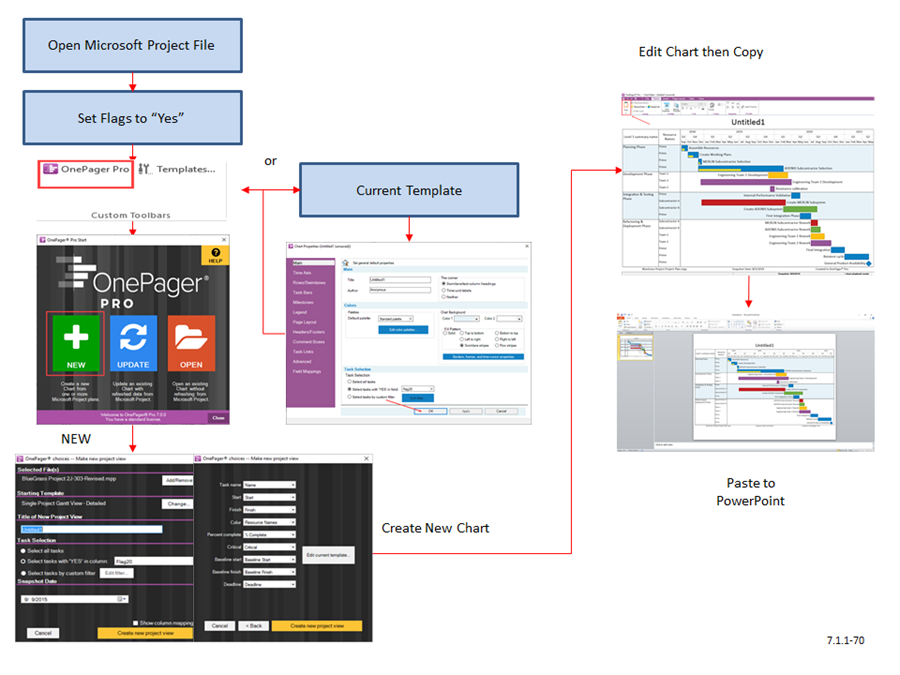
Procedure
Preparing the Microsoft Project Source Plan
Launch Microsoft Project and access the required Microsoft Project source plan. Set the Flags/Numbers field into the Microsoft Project source plan. This is the flag that OnePager uses to determine which tasks and milestones to import. Determine which of the tasks and milestones are to be included and set the Flags/Numbers field cell to Yes for these while leaving the remainder of the task's and milestone's Flag field set to No, 0, or blank.
Launching OnePager Pro Add-In
Click the OnePager button on the Microsoft Project ADD-INS ribbon tool bar tab to launch OnePager Pro at the OnePager Pro Start form.
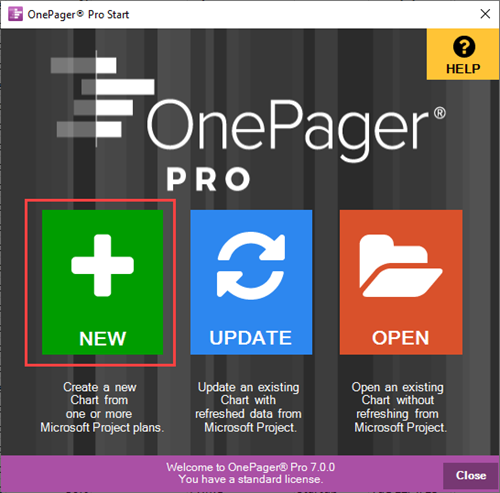
If you need to adjust settings in the OnePager current Template Properties form before launching OnePager Pro, click the Template... button on the Micosoft Project ADD-INS ribbon tool bar tab accesses a window with the Template Properties form which can be edited and saved.
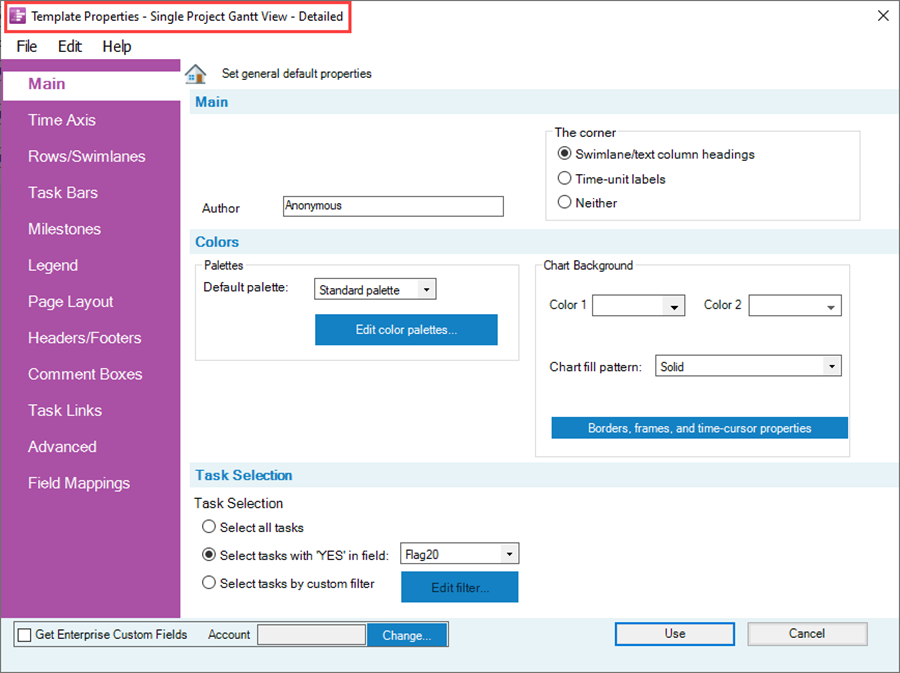
The Template Properties form is very similar to the OnePager Chart Properties form which is described elsewhere. Once the desired edits to the current Template Properties form are made, save the Template Properties form and return to paragraph 5) above. At the completion of paragraph 5) when you click the NEW button, OnePager accesses the OnePager choices (OPC) form as shown below:
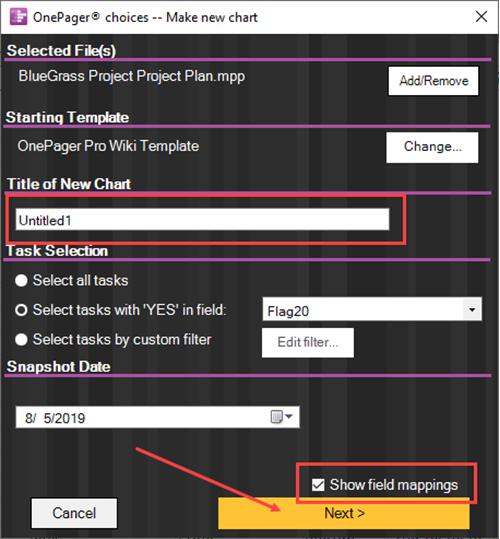
It is recommended that the chart name selected refer to both the project and, perhaps, be familiar to the audience that is likely to view the completed OnePager chart. Additionally, notice that the Select Tasks with ‘YES’ in field: is showing Flag20 as a default. Most users select Flag20 to tell OnePager which tasks and milestones to import but any of the 20 Flag fields or any of the 20 Number fields can be used. It is important that the Flag field number represented in this window correspond to the Flag field containing the Yes and No data placed in the Microsoft Project source plan.
The Snapshot date represents the time now or as-of date for the chart you are about to create. If the date created by OnePager does not reflect the status date required, change the date by using the calendar dropdown window. As the source plan changes later on, you can create additional snapshots to show changes consistently.
Finally, note that the Show field mappings checkbox is checked ON as shown above. Checking this checkbox ON and pressing the Next> button takes you to the second page of the OPC form shown below:
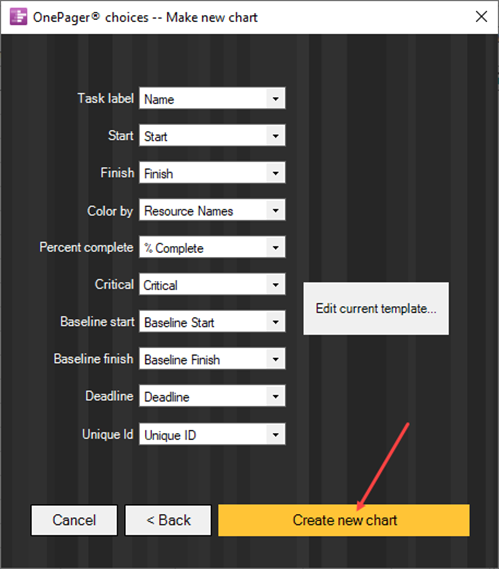
This form allows you to edit which Microsoft Project source plan fields are used for various purposes such as the Start field and the Color by field. The Edit current template button also gives you a second opportunity to edit many more initial properties of the chart by accessing the current Template Properties form. Once these choices are confirmed or edited, click the Create new chart button and OnePager imports the flagged data and creates the chart.
Once the chart is created, you can edit by right-clicking task bars and milestone symbols and using the context menus commands. You can also left-click on task bars and milestone symbols and use the editing Icons on the OnePager ribbon tool bar tabs. You can also left-click on a task bar or milestone symbol and use the mouse to drag the selected task bar or milestone symbol up or down from row to row in the chart. When the desired editing is complete, click the Copy to Clipboard button on the OnePager Home ribbon tool bar tab and then paste the chart into a Microsoft PowerPoint presentation, email message, or Microsoft Word document. If the chart contains more than one page, you can choose to copy the entire document, the last page (current page), or a selected numerical page to the clipboard. OnePager can save all charts and snapshots after editing.
Related Links
Creating a NEW Chart via Pull Operation - OnePager Pro
Creating a NEW Chart via Pull Operation - OnePager Express
REPLACING a Snapshot via Pull Operation - OnePager Pro
REPLACING a Snapshot via Pull Operation - OnePager Express
ADDING a Snapshot via Pull Operation - OnePager Pro
ADDING a Snapshot via Pull Operation - OnePager Express
Custom Update (Replacing) of a Snapshot via Pull Operation - OnePager Pro
Custom Update (Replacing) of a Snapshot via Pull Operation - OnePager Express
Using the OnePager "Data" Tab's "Selected file(s)" Button
(7.1.1-70)
Overview Flow Chart
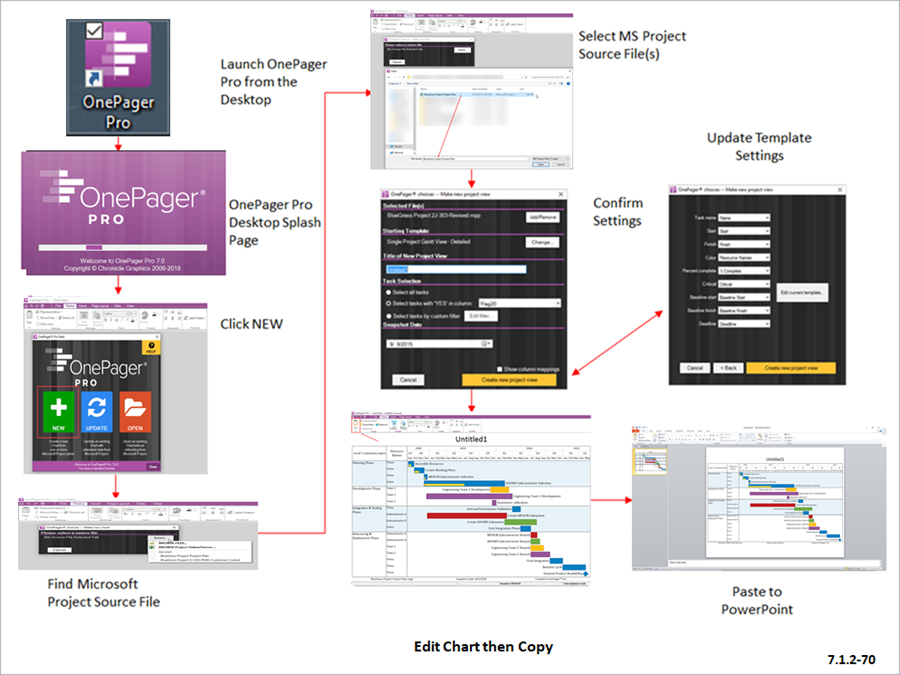
Procedure
Preparing The Microsoft Project Source Plan
After launching Microsoft Project with your desired source plan, set Flags/Numbers field into the Microsoft Project source plan. This is the Flag that OnePager uses to determine which tasks and milestones to import. Determine which of the tasks and milestones are to be included and set the Flags/Numbers field cell to Yes for these while leaving the remainder of the task's and milestone's Flag field set to No, 0, or blank. At this point your Microsoft Project source plan can be saved and closed. The Desk top version of OnePager Pro does not require that the Microsoft Project source plan be launched first. The part of the procedure described above are in preparation for using the Desk top version of OnePager Pro.
Launching OnePager Pro Desktop
Launch OnePager from the Desktop Icon. The OnePager splash page appears briefly followed by the OnePager Chart Editor form displaying the OnePager Pro Start form as shown below:
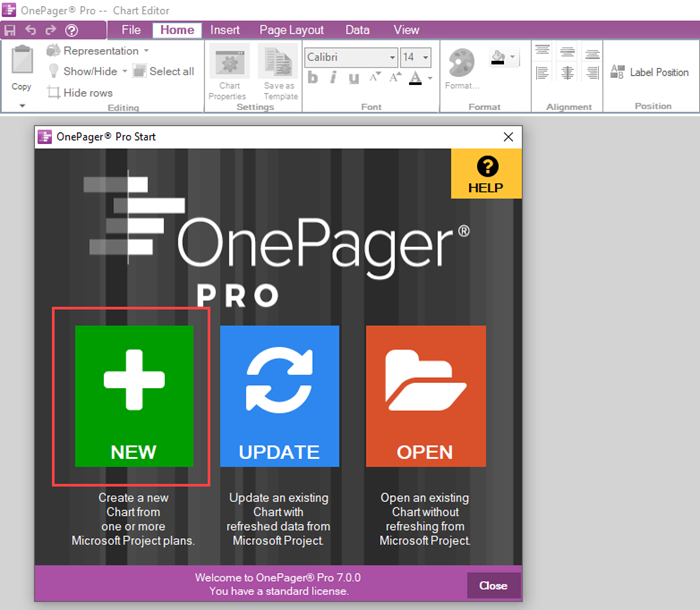
At the completion of paragraph 6) when you click the “NEW” button, OnePager displays an abbreviated OnePager choices (OPC) form.
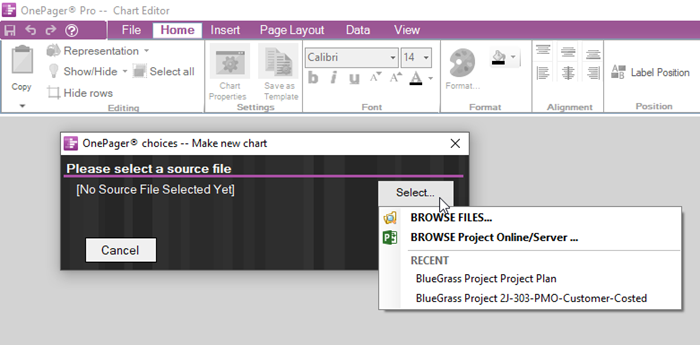
When you click the Select button shown above, OnePager then provides a dropdown menu for you to either choose to use the BROWSE FILES... to select a source plan or click the RECENT MS Project Files... option to access Microsoft Project Server source files as shown above. Clicking the BROWSE FILES… option as shown above accesses a Windows Open form where you can select a Microsoft Project source plan to load as shown here:
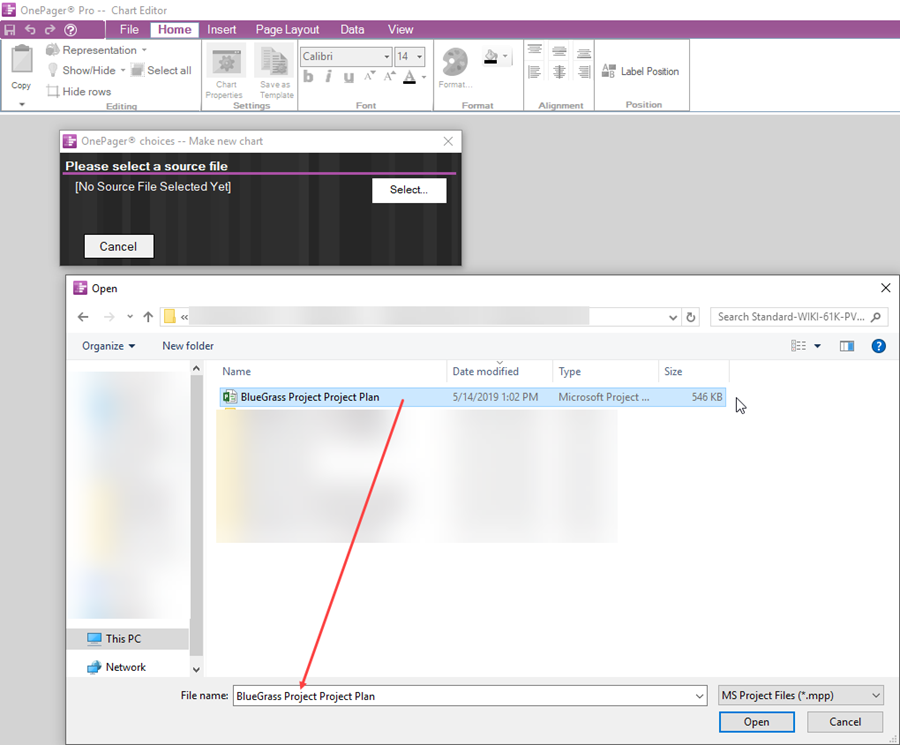
When you click the Open button on the Windows Open form above, OnePager loads the selected Microsoft Project source plan and provide you with the expanded OPC form so that you can confirm or edit the settings before OnePager creates the new chart.

As shown above, OnePager displays the loaded Microsoft Project source plan in the Selected File(s) group of the OPC form. You can use the Add/Remove feature (described elsewhere) to edit the choice of Microsoft Project source plan, add additional files to the source packet, and remove files. Clicking the Add/Modify button accesses the Data source selection form as shown below:

It is recommended that the chart name selected refer to both the project and, perhaps, be familiar to the audience that is likely to view the completed OnePager chart. Additionally, notice that the Select Tasks with ‘YES’ in field: is showing Flag20 as a default. Most users select Flag20 to tell OnePager which tasks and milestones to import but any of the 20 Flag fields or any of the 20 Number fields can be used. It is important that the Flag field number represented in this window correspond to the Flag field containing the Yes and No data placed in the Microsoft Project source plan.
The Snapshot date represents the time now or as-of date for the chart you are about to create. If the date created by OnePager does not reflect the status date required, change the date by using the calendar dropdown window. As the source plan changes later on, you can create additional snapshots to show changes consistently.
Finally, note that the Show file mappings checkbox is checked ON as shown above. Checking this checkbox ON and pressing the Next> button takes you to the second page of the OPC form shown below:
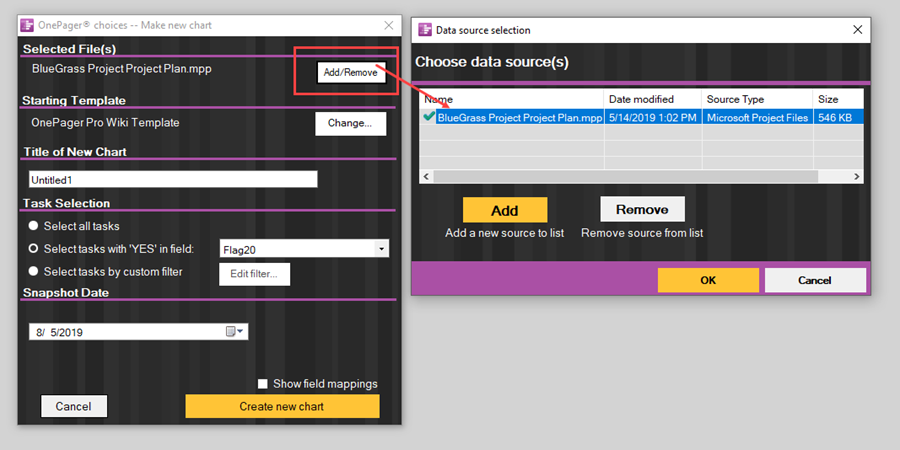
This form allows you to edit which Microsoft Project source plan fields are used for various purposes such as the Start field and the Color by field. The Edit current template button also gives you a second opportunity to edit many more initial properties of the chart by accessing the current Template Properties form. Once these choices are confirmed or edited, click the Create new chart button and OnePager imports the flagged data and creates the chart.
Once the chart is created, you can edit by right-clicking task bars and milestone symbols and using the context menus commands. You can also left-click on task bars and milestone symbols and use the editing Icons on the OnePager ribbon tool bar tabs. You can also left-click on a task bar or milestone symbol and use the mouse to drag the selected task bar or milestone symbol up or down from row to row in the chart. When the desired editing is complete, click the Copy to Clipboard button on the OnePager Home ribbon tool bar tab and then paste the chart into a Microsoft PowerPoint presentation, email message, or Microsoft Word document. If the chart contains more than one page, you can choose to copy the entire document, the last page (current page), or a selected numerical page to the clipboard. OnePager can save all charts and snapshots after editing.
Related Links
Creating a NEW Chart via Pull Operation - OnePager Pro
Creating a NEW Chart via Pull Operation - OnePager Express
REPLACING a Snapshot via Pull Operation - OnePager Pro
REPLACING a Snapshot via Pull Operation - OnePager Express
ADDING a Snapshot via Pull Operation - OnePager Pro
ADDING a Snapshot via Pull Operation - OnePager Express
Custom Update (Replacing) of a Snapshot via Pull Operation - OnePager Pro
Custom Update (Replacing) of a Snapshot via Pull Operation - OnePager Express
Using the OnePager "Data" Tab's "Selected file(s)" Button
(7.1.2-70)